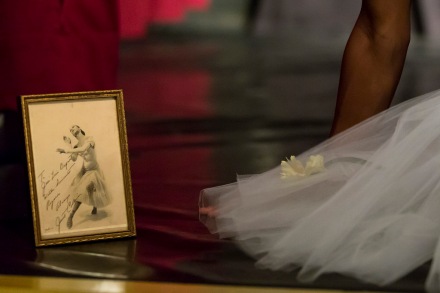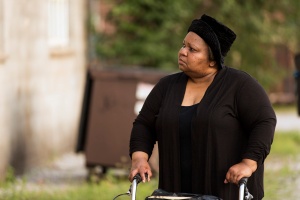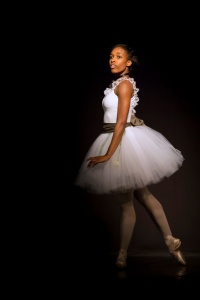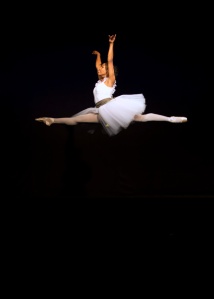This post tells the story of my personal, and very limited, involvement in a film about the ballet career of Janet Collins. People of Color are used to being the outsiders, the exoticized, the other, in almost every aspect of life in Western culture. But being classified as other is still better than being shut out altogether. In her career, African-American ballerina Janet Collins was more than just an outsider. She was the outsider who eventually broke the mold of only allowing white bodies to fully participate in ballet.
Janet is a silent ballet film that celebrates her timeless contribution to the world of ballet. As the first African-American prima ballerina to dance full time with a major company, Janet Collins made herself heard by the institutional power that had silenced the voices of PoC for generations. This film was written, directed, and produced by Adam E. Stone.
Note: Featured image by Michelle Greene
The film begins with a very clear depiction of a WoC as an outsider. The actress in the image below is an artist who creates wonderful Rembrandt-style portraits. This image of DeSande R as an outsider appeals to me, because I have felt very much like an outsider throughout my life. My involvement in this film was cathartic for me, so I will begin from my perspective and widen the view from there.
Earlier this year, I was approached by an independent filmmaker. Before you ask how I, an introverted writer, could possibly know a filmmaker, let me assure you that it wasn’t my doing. It was one of those things that introverts typically get dragged into by an extroverted friend. My best friend, who is a classically trained Mezzo Soprano, has taught voice and performed at a number of places. She is an excellent performer, and she also happens to know a ton of entertaining, musical, artistic, and theatrical people. Adam Stone, the filmmaker who contacted me, is one of these talented people. When he approached my friend about doing a voice part in a film that was originally supposed to have been a spoken word ballet, she also recommended me for a small part. After I expressed interest in the part, Adam contacted me with the details of the role.
What followed was one of the more interesting endeavors of my life.
Adam mailed me the text for three separate monologues, a CD with the tone, inflection, and tempo he wanted for each monologue, and a contract for me to sign. After practicing the monologues for several weeks, I met with Adam to do the actual voice recording.
Yes…silent, introverted me!
To say that I was incredibly nervous would be the understatement of the year, but Adam understood and helped me overcome the nerves. We sat at his kitchen table and read through each of the monologues several times. Through each reading, he gave me instructions on how to interject more emotion into my voice. Sometimes a line called for a softer, more vulnerable tone, and sometimes it called for a little more force with an edge of attitude—attitude that did not come natural to me. After about an hour of reading at the table, it was time to go to the studio.
Now is the time for me to mention that I am NOTHING like my best friend. She is musical and effervescent and talented. She is not a shy shrinking violet like me. She has a magnificent voice that does not need a microphone to be heard, even with a choir singing in the background. She shines in the way people who were born to be famous performers shine, and when she performs she gives people goose bumps. Her voice is power; her voice is trained; her voice is the bomb…
Mine? Not so much.
So the idea of going into a recording studio, even if it was just to read, had me defeating myself with negative self-talk. Either way, it was too late to back out. I had already agreed to do it, practiced the monologues, signed the contract, and received payment. I was going to record those monologues no matter what. I had to.
Adam and the studio manager explained the basics of studio recording to me. I was shown into a large room with a microphone and a pair of headphones set up for me to use. They explained that, through the headphones, I would be able to hear myself as I spoke into the microphone. I would also be able to hear Adam if he had any pointers to give me during the recording session. Between takes, I was able to exit the recording room and sit in the control room as they played back the recording of my voice and edited each line. The first time I heard my voice over the loud speakers, it felt strange and foreign to me. Did I really sound like that? The voice on the speakers had a higher pitch and sounded younger, more unsure, and more tremulous than the voice that came out in my head. My voice was straight up wimpy, and I didn’t like it.
But I had to listen to it as Adam and the studio manager replayed certain lines of the recording over and over again. I have to go back into the recording room several times between each take to re-record a single line here and there. The entire process took all afternoon, and by the end of it, I was accustomed to the sound of my own voice.
Why is this such a big deal?
Because the voices of People of Color, Women of Color in particular, have been silenced for so long in this society that it never occurred to me that mine matters.
From a very young age, I learned the same lesson that almost every other PoC learns; I don’t matter. My opinions don’t matter, unless all I’m doing is agreeing with the status quo. My experiences with racism and prejudice don’t matter, because no one wants to hear from people who “play the race card.” My feelings don’t matter, because I am not a member of the dominant culture. My humanity doesn’t matter, because people with darker skin are still seen as subhuman in a lot of ways. My self-esteem doesn’t matter, because black girls are ugly anyway—so why should we have good self-esteem? My entire existence has pushed me to the conclusion that my voice doesn’t matter.
Yet, on that day, my voice mattered.
Flash forward to the filming and editing, and the long awaited final product…

Four Edgar Degas paintings come to life in this haunting silent ballet film about alienation, acceptance, and the powerful, enduring legacy of Janet Collins, the first African-American prima ballerina to dance full time with a major company, the Metropolitan Opera Ballet in 1951.
I received a message from Adam, informing me that he had decided to take a very different creative direction. Instead of keeping the film a spoken word ballet, in which the paintings come to life and dance to the sound of our monologues, the film was to be a silent ballet.
After all that personal growth and work for me to come out of my well-constructed introvert shell, my contribution wasn’t to be used after all.
Adam was very gracious about telling me that my part had been cut, and he sent me a link to the finished film. Once I saw the film, I understood why he chose to make the film a silent ballet. It wasn’t that my voice wasn’t good enough; it was that silence was more effective. The film had a far greater impact on me as a silent ballet than it would have if there had been monologues.
The silence invites the audience to enter the experience in a contemplative and quiet state of mind. It tells the story of Janet Collins, the first African American ballerina at the Metropolitan Opera. But, the film tells her story without telling her story. Each dance scene is a moving picture that tells the audience more than a thousand words.
The image of the Black ballerina dancing on a grassy knoll, after being shunned by her White counterparts, seeps directly into the viewers’ conscious. Emotions awaken without the dramatic swell of music or the theatrical inflection of a voice giving a monologue. Instead, the silence of the film invites the viewer to fill in their own personal music—just how the filmmaker intended.
Janet Collins’s struggle to become a successful ballerina, in a world of racism and White supremacy, is depicted softly, elegantly even, in the changing expressions of the Black ballerinas in the film who hide backstage and watch the White ballerinas perform. We see the hope in their faces as they wait their turn—silently.
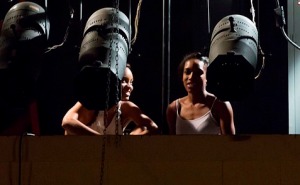
Kiara Felder (Atlanta Ballet) and Nayomi Van Brunt (New York Theatre Ballet) Photo by Michelle Greene
When their turn to dance comes, joy is depicted using the fluidity of movement rather than sound.

Kiara Felder (Atlanta Ballet) and Nayomi Van Brunt (New York Theatre Ballet) Photo by Michelle Greene
Black voices and expression were so silenced in Janet Collins’s time that, even though she did enjoy a career as a ballerina, it wasn’t as full bodied and prolific as it would have been had she not been shut out for so long.
Janet celebrates the, often overlooked, contribution of PoC to the arts. In particular, this film celebrates Janet Collins in the most simple, yet impactful way. It allows you to see her story through the silent movements of some of the very women whose ballet careers she helped make possible.
DIRECTOR’S STATEMENT:
My decision to make a completely silent ballet film was influenced not only by the fact that members of non-dominant cultures historically have been, and to some extent continue to be, “silenced” within the world of classical ballet, but also by my desire to connect the film explicitly to the worlds of painting (as exemplified in the film by the four Degas paintings that come to life) and photography (as exemplified by the four ballet photos–of Adeline Genée, Daphne Dale, Harriet Toby, and Janet Collins–that play a key role in the film), worlds in which meaning has traditionally been conveyed without sound, and in which a work of art stands or falls strictly on the basis of whether its meaning, or story, has been successfully expressed by the use of the visual image alone. The film also pays homage to the great Russian ballerina Anna Pavlova (1881-1931), the dancer who most inspired Janet Collins: Pavlova once told an interviewer that she planned “to try the experiment of a ballet without music some day,” because she thought it “logical to suppose that dancing should call forth a melody in the brain of those who witness it,” and such a ballet would allow every viewer to be “his or her own composer” – a sentiment that adds to and enriches the ideas about “silence” expressed by composer John Cage in his seminal 4’33” and earlier works. My hope is that the film inspires both reflection and action, and above all honors the legacy of Janet Collins and other early ballet dancers of color.
When/Where you can see this film:
- October 14th-16th at the Urban Mediamakers Film Festival: http://www.umff.com/mpages/umff2014-films-shorts-2.html
- December 4th -14th through The INTERNATIONAL BLACK WOMEN’S FILM FESTIVAL (online streaming is also an option during this festival): http://www.ibwff.com/festival/#section-1
More about the filmmaker: http://adamestone.com/wordpress/

